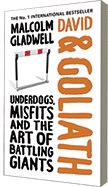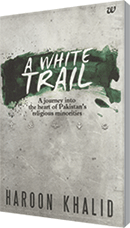 David & Goliath by Malcolm Gladwell; Penguin Books; Price: Rs.599; Pages 305
David & Goliath by Malcolm Gladwell; Penguin Books; Price: Rs.599; Pages 305
A STAFF WRITER of the well-known New Yorker magazine, Malcolm Gladwell is among the most original and innovative of contemporary thinkers. During the past decade or so, he has written several stimulating books traversing politics, sociology, psychology and anthropology which have refreshingly challenged conventional prejudices and myths, providing insightful explanations of human motivations and behaviour.
The Tipping Point (2000) explained how great ideas, new behavioural norms and revolutionary messages that change the mindsets and histories of nations, are communicated within societies and given wing by people classified as “connectors”, “salesmen” and “mavens”, pushing societies to tipping point — “levels at which change becomes unstoppable”. In Outliers (2008) Gladwell extended his observation to the conundrum of people with exceptional ability and high IQ who don’t make it to the top of the greasy pole of success.
In Blink (2005) he advised readers not to under-estimate the accuracy of first impressions and the power of intuition. And in What the Dog Saw (2009), Gladwell reconstructed events such as the Challenger spaceship disaster of 1986 in which seven astronauts perished and complex cultural phenomena such as societal acceptance of women unapologetically colouring their hair.
His latest international bestseller David & Goliath which has as its subtitle ‘Underdogs, Misfits and the Art of Battling Giants’ is inspired by the biblical face-off between the fully armoured man mountain Goliath representing the Philistines, and the Israeli shepherd boy David equipped with a mere slingshot which resulted in a victory for the latter. Through engaging vignettes and anecdotes, Gladwell disproves conventional wisdom, and highlights how hopelessly disadvantageous, difficult and overwhelming situations can be transformed into improbable victories.
Divided into three sections, each represents three case histories to demonstrate the “advantage of disadvantages”, the “theory of desirable difficulty” and the “limits of power”. Can a Mumbai-born father who had never played basketball coach his daughter Anjali’s team to win the National Junior Basketball tournament in America? Vivek Ranadive “was an underdog and misfit, and that gave him the freedom to try things no one else dreamed of” and succeed beyond expectations.
In the second story in the first section, Gladwell busts the popular belief — a selling point of elite schools — that favourable teacher-pupil ratios necessarily result in better learning outcomes. And in the third, through the sad history of one Caroline Sacks, the author illustrates that failing to secure admission into the university of your choice could be a blessing in disguise.
In the second part of this iconoclastic compendium, Gladwell argues that graduating from the school of hard knocks and experiencing “a desirable degree of difficulty” could greatly improve your chances of success in life and chosen vocation. Which parent would welcome dyslexia in her children? The histories of David Boies, today “one of the most famous trial lawyers in the world”, and Brain Grazer “now one of the most successful movie producers in Hollywood”, in Gladwell’s latest oeuvre show how these individuals turned their adversities into brilliant advantage.
Part three of this collection discusses “the limits of power” — of how ordinary men and women of no particular promise or distinction but endowed with dogged determination, successfully challenged state/government power. To support his argument that excessive use of police/military force upon civilians can precipitate unstoppable people’s movements, Gladwell brings to life the case histories of a Catholic housewife in Northern Ireland, a couple who through their insistence on conferring the Christian power of forgiveness pushed down crime rates in California, and the small community of Le Chambon in German-occupied (Vichy) France which defied the mighty German army and gestapo by persistently giving refuge to Jews fleeing Nazi persecution during the Second World War. In short, argues Gladwell, non-conformist, disagreeable and obstinate individuals are valuable to society and need to be tolerated.
To contextualise and update this narrative, surely the dramatic rise of the Aam Aadmi Party in Indian politics is a David and Goliath story, provoked by the open, continuous, uninterrupted corruption of the Congress party and the stubborn insistence of its leader Arvind Kejriwal, who is hell-bent on exterminating it. Similarly, continuous and sustained neglect and abuse of the country’s hapless children who didn’t invite themselves into India’s child-hostile society has prompted the maverick promotion of the Children First Party of India. Some social good is sure to emanate from this seemingly hopeless enterprise.
Dilip Thakore
Beleaguered minorities
A White Trail by Haroon Khalid; Westland; Price: Rs.395; Pages 330
AT THE TIME OF of Partition (1947), religious minorities constituted 25 percent of Pakistan’s population. Today, they comprise a mere 3 percent. Over the years, endemic discrimination practised by the state and civil society forced the continuous emigration of minorities from the country. Today members of Pakistan’s shrinking minorities live in increasingly precarious circumstances. In the self-styled ‘Land of the Pure’, even Muslim citizens face grim conditions — economic crises, political anarchy, ethnic strife, violence, terrorism etc. The plight of Pakistan’s religious minorities is worse as this book poignantly reveals.
The white stripe on Pakistan’s national flag symbolises its religious minorities — the White Trail that gives the book its title. This volume is one of the first on the subject of the major communities that compose the White Trail: Hindus, Sikhs, Christians, Bahais and Parsis. The author, a journalist with the Lahore-based Friday Times, writes about them with great sensitivity and concern for the multiple problems they face.
Inevitably, Hindus are the single largest ethnic minority, the majority of them Dalits from the bottom of the Hindu caste hierarchy. The upper castes migrated to India during the bloody Partition of the subcontinent. Pakistani Hindus mostly live in the relatively more liberal and tolerant southern Sindh province where they make up a sizeable percentage of the population. In these districts, their caste profile is more diverse than in Punjab, and they include some upper caste industrialists, traders and landlords as well.
As can be imagined, life is far from easy for Hindus of Pakistan, especially in the Punjab province. Khalid relates how their patriotism is continuously doubted by other Pakistanis, which obliges the former to constantly stress their nationalist credentials. Moreover as Dalits, not only is their economic condition precarious, they suffer age-old indignities under Muslims, although such discrimination is disallowed by Islam.
Violence against Muslims in India sometimes invites retaliatory violence against Hindus in Pakistan. Hatred for the latter is also routinely propagated in the government school system, through textbooks that vilify them as kafirs — enemies of Muslims. Nevertheless, as Khalid acknowledges not without admiration, this has not deterred scattered groups of Pakistani Hindus from asserting their identity, and demanding rights with the formation of new organisations in recent years.
Pakistan’s Christians number only slightly less than the country’s Hindus, but they are somewhat more vocal. This has much to do with the large number of Christian institutions in the country — hospitals, schools, and colleges. Like Hindus, most Pakistani Christians too are Dalits, and discrimination rings loud against the community. The horrific targeting of Christians (and others, too) under anti-blasphemy laws has received considerable global attention. In recent years, attacks on churches and other Christian institutions by radical “defenders of Islam” has also taken a heavy toll. Khalid’s Christian respondents, whom he meets in churches and pilgrimage centres in Punjab, tell stories of their grievances in the face of rampant discrimination, and how they struggle to survive.
A rich islamic sufi tradition once flourished in what is now Pakistan and preached peace, love, compassion and harmony which transcended narrow boundaries of caste and creed. Their liberal interpretation of Islam can have crucial implications on the fortunes of Pakistan’s beleaguered minorities, and this is something that Khalid could have discussed. After all, the travails of minorities have much to do with the unfortunate conflation of Pakistani nationalism and misplaced Muslim supremacism which is premised on the denigration of people of other faiths.
This well-researched and engagingly written account of the fault lines between Muslims and Pakistan’s minorities cannot afford to be missed by anyone interested in contemporary Pakistan.
Yoginder Sikand



























